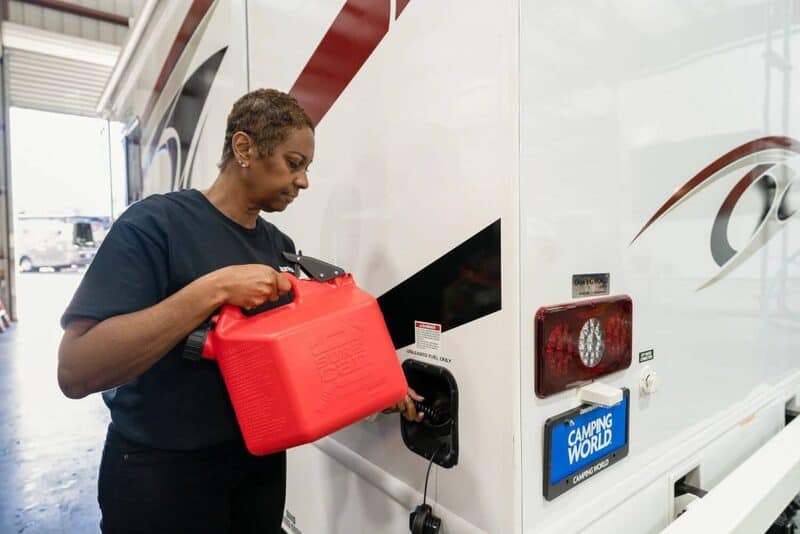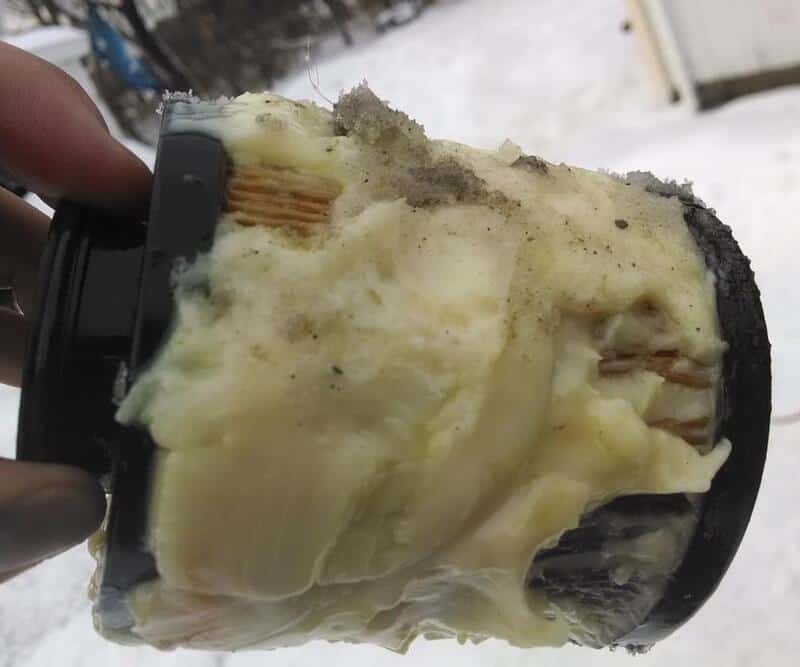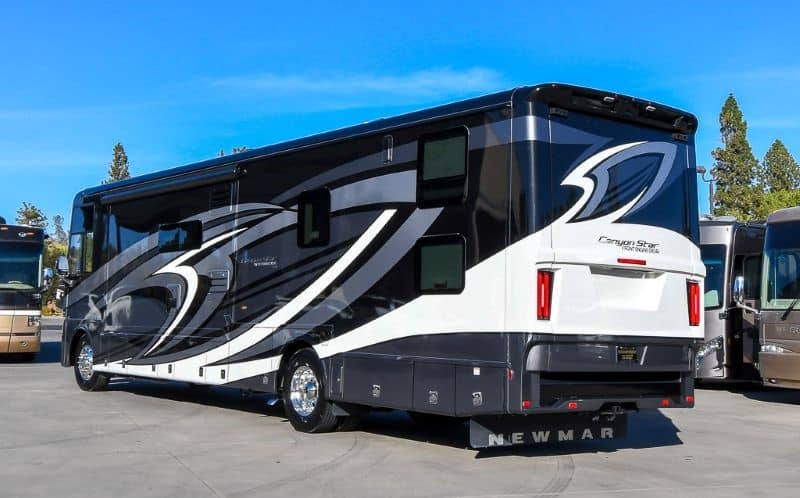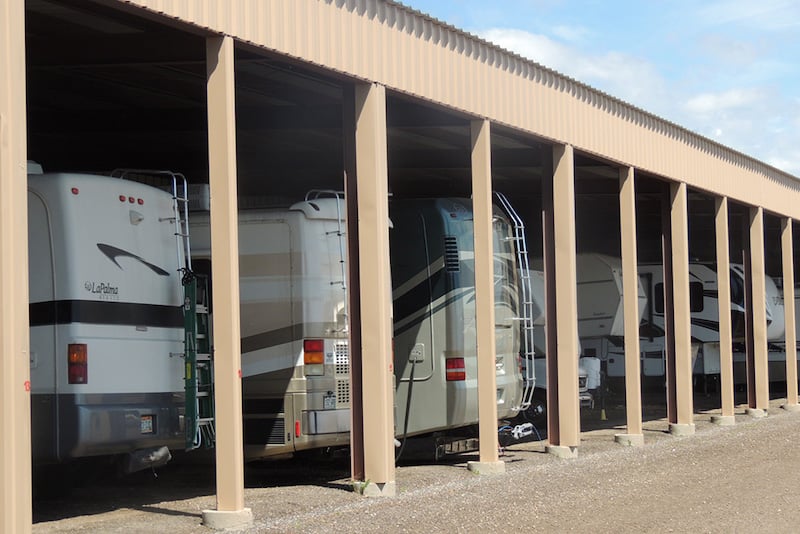We have several friends that are making the trek to Alaska this year and so the question came up: What is the freezing point of gasoline? So we did a little research including talking to some of our friends who used to live in Alaska where they experienced sub zero temperatures.
Motorhome owners must take special note of the freezing point of gasoline. Frigid temperatures pose a risk to any type of camper. But, if fuel freezes in the tank or fuel lines of your motorhome it can be disastrous.
The freezing point of gasoline is -100 F. In fact, ordinary travelers will likely never experience anything close to the subzero temperatures required to solidify gasoline. However, the additives in commercial gasoline freeze at much higher temperatures.
Diesel fuel also begins to gel and freeze at just 32 degrees Fahrenheit. Not to mention that any type of fuel tank can leave room for air, and therefore water condensation. This condensation is also susceptible to freezing at just 32 degrees.
Even before diesel or gasoline’s freezing point is reached, fuel will thicken and gel. This causes the filter to clog and the engine to perform poorly and eventually stop running altogether.
It is important to understand the freezing point of gasoline and diesel fuel. This is especially the case if you plan to travel or store your motorhome where temperatures routinely dip. You can prevent costly damage to your RV if you know what to watch for and take the appropriate precautions.
Can Gasoline And Diesel Freeze In Your Vehicle Tank?
Yes, diesel and gasoline can both freeze in your motorhome’s tank. It takes extreme temperatures for gasoline to freeze solid. However, the additives in both gasoline and diesel begin to gel and crystallize at just 32 degrees Fahrenheit.
In reality, gasoline will begin to gel and not flow through your gas lines at about -30 to -40 F. And diesel fuel will begin to gel at about 15 F.
This can clog your fuel filter and cause the fuel to become unusable until it thaws and fully re-liquifies. The gelling process could occur overnight or simply while you’re traveling down the road. You’ll want to take action to prevent this gelling so you can continue to enjoy your motorhome in all climates.
What Is The Freezing Point Of Gasoline And Diesel?
The exact freezing point of gasoline is difficult to determine because gasoline is a mixture of various elements. For gasoline to fully freeze, temperatures must reach about -100, which most RVers will ever experience. However, any cold weather can potentially damage your fuel system.
Gasoline can contain impurities and contaminants that have a higher or lower freezing point than the gasoline itself. Additionally, water can accumulate in the fuel tank and freeze at just 32 degrees Fahrenheit.
In very cold temperatures, gasoline can thicken or gel, becoming difficult to pump and potentially even clogging your fuel filter. Freezing is a worst-case scenario but gelling gasoline is also a big problem.
Diesel fuel is at even more risk of gelling. Anytime temperatures dip below 32 degrees Fahrenheit the paraffin in diesel fuel starts to stiffen. This causes the fuel in the tank to become clouded.
You may still be able to drive at this point, as diesel fuel likely won’t fully solidify until temperatures are closer to 15 degrees Fahrenheit. However, any clouding in your fuel tank is a warning sign that you should add anti-gel to prevent engine damage.
What Happens If Your Gasoline Freezes In Your RV?
Gasoline’s freezing point is very low, so it’s unlikely that you’ll ever experience temperatures that cause gasoline to freeze completely. However, as it becomes colder, gasoline will thicken. This can cause your fuel pump to work harder, over time reducing the pump’s lifespan.
The freezing point of diesel fuel is higher than that of gasoline. Thus diesel-powered motorhome engines are even more susceptible to damage. Winter diesel blends are better suited to cold environments. Choose a winter blend if you know your diesel motorhome will be used or stored in very cold temperatures.
The thickening, and eventual freezing of fuel, or at least some of the components in your fuel, can happen regardless of whether you drive a diesel or a gasoline-powered motorhome.
Fuel lines are more susceptible to problems in freezing temperatures than even your motorhome’s fuel tank. There is less fluid running through the lines and these lines are typically more exposed to the elements.
Frozen fuel lines mean the engine will not start. If the lines aren’t completely frozen, you may hear the engine turn over, but this won’t be enough to actually start the vehicle if the lines are in the process of freezing. Once temperatures warm, you should be able to start the motorhome once again.
Moisture in the tank can freeze and cause performance issues too. If just one of the fuel lines is blocked by this expansion from freezing, it can also severely inhibit performance without preventing the engine from running altogether.
You may notice sputtering or stalling in colder temperatures. If this happens to your motorhome, consider that the components in your fuel may be nearing their freezing point.
How Freezing Weather Affects Your Motorhome
When temperatures dip below the freezing point of gasoline, more than just your RV’s fuel system is at risk. Cold temperatures pose a variety of threats to the workings of your motorhome. Here are some hazards you need to watch out for when the temperatures drop.
1. Frozen Plumbing And Water Tanks
Frigid temperatures can do more than just freeze your fuel lines, they can also freeze your water lines. Since water freezes and expands at 32 degrees Fahrenheit, freezing temperatures can cause cracks in your RV’s water lines as well as in your fresh water, gray water, and black water tanks.
Always add RV antifreeze to the plumbing in your rig if you suspect that temperatures may dip below freezing. If it’s cold enough outside to worry about fuel freezing it’s definitely cold enough to freeze water, this means your RV’s plumbing system is at risk.
2. Fuel Lines Can Freeze In Diesel Motorhomes
Since diesel fuel has water moisture and paraffin wax in it, diesel motorhomes are especially susceptible to frozen fuel lines. Components in both gasoline and diesel fuel can begin to gel and crystalize in cold temperatures. However, the components in diesel fuel make it especially susceptible to freezing.
Diesel motorhomes are more likely to experience frozen fuel lines. Once the diesel fuel becomes too cold it gels and clouds preventing combustion and clogging filters as well.
If you’ll be traveling or parking your rig in a very cold climate, you’ll want to use a fuel additive that prevents freezing.
3. Freezes Living Area
Freezing weather can also cause your RV living space to become unbearable. In extremely cold temperatures, water lines and tanks can freeze, leaving you without indoor plumbing.
Additionally, ice can form on your refrigerator’s evaporator. If this happens the refrigerator will not work properly and you won’t be able to safely store food. Cold temperatures can also make it difficult to sleep or even reside comfortably, as the living space in your RV can become quite cold.
If your RV was not built specifically for cold climates, you’ll need to consider adding additional space heaters and/or insulation. RV use in cold climates is doable but it requires some extra steps.
4. RV Battery Power Drain
Cold weather can also drain your RV battery power. Lithium batteries as well as lead acid batteries both operate less efficiently and lose the ability to be charged when temperatures dip.
The charging efficiency of lead-acid RV batteries drops to just 50% when temperatures dip below -4 degrees Fahrenheit. Additionally, the water inside lead acid batteries can freeze making them useless until warmed.
Lithium batteries don’t fare much better. They are unable to be charged at temperatures below 32 degrees Fahrenheit. Additionally, if you discharge a lithium battery in very cold temperatures you can cause permanent damage to the battery.
Cold temperatures mean that you’ll need to charge your battery more frequently. But keep in mind that battery life is typically measured in charge cycles. While Lithium batteries are generally rated for 3,000-5,000 charges, lead-acid batteries only last about 400 charge cycles.
The bottom line is that cold temperatures are bad for all types of RV batteries. If camping or storing your RV in frigid temps is a must, always keep your battery fully charged. A trickle charger or battery maintainer is a great option.
This will help prevent damage to your RV battery. A trickle charger can be a good idea. Additionally, you may want to invest in an insulated battery compartment, a battery heater, or a battery blanket to help keep your RV battery warm.
3 Ways To Protect Your Motorhome In Cold Climates
RVing in very cold temperatures can be intimidating, but fortunately, there are several ways you can protect your motorhome.
1. Use An Anti-Freeze Fuel Additive For Diesel Motorhomes
When temperatures are expected to dip below the fuel’s freezing point, you need to work to protect your motorhome.
Your first course of action should be to add an anti-gel agent or gas-line antifreeze to your fuel system. These additives will lower the freezing point of diesel or help prevent the additives in gasoline from freezing.
Anti-gel additives are intended to lower the Cold Filter Plugging Point (CFPP). CFPP is considered to be the lowest temperature at which fuel will still flow through a specific fuel filter. Lowering the CFPP keeps your engine running longer even when temperatures dip.
While some diesel fuel may already have anti-gel agents added, it’s difficult to know if the concentration is sufficient to prevent fuel from reaching its freezing point. Therefore, it’s always advisable to treat your tanks with a cold-weather additive to ensure your fuel will not freeze or even begin to gel.
Similarly, most gasoline now contains a minimum percentage of ethanol, which often works in the same way as the alcohol additives found in gas-line antifreeze. Still, it won’t hurt to add a gas-line antifreeze to your tanks if you know that you’ll be experiencing extremely cold temperatures.
2. Store Your Motorhome With A Full Tank Of Fuel

Always store your motorhome with a full tank of fuel. A less-than-full tank leaves room for air, and air contains moisture. Condensation can form, and then in cold temperatures that water can freeze and expand.
Water freezes at just 32 degrees Fahrenheit, which is much warmer than the freezing point of gasoline. Diesel also begins to freeze at 32 degrees, but fortunately, there are fuel additives to lower this freezing point. Any condensation in your tank isn’t treatable with an antifreeze agent and is therefore at even greater risk of freezing.
Store your motorhome with a full fuel tank to eliminate space for air and condensation, thus further protecting your rig.
3. Make Sure Your RV Hydronic Heating System Heats The Engine
Fortunately, many motorhome manufacturers take measures to help prevent fuel from freezing in your tanks. When shopping for an RV, look for one with a hot water heating system that is routed around the engine.
Even when the motorhome’s engine is off, these hot water pipes will help keep fuel, oil, and other engine liquids from freezing. Both Aqua-Hot and Oasis systems offer this option. This hot water routing method is key to preventing engine temps from dipping below the freezing point of the fuel.
Final Thoughts On How The Freezing Point Of Fuel Affects Your RV
When temperatures dip below the freezing point of gasoline or diesel it can be disastrous for your motorhome. Fortunately, there are many ways to prevent this from happening.
Whether you plan to drive, camp, or store your motorhome in frigid temps, always add an anti-gel or antifreeze additive to your fuel tanks. Store your motorhome with a full fuel tank to prevent condensation that can also freeze and cause damage.
Remember that fuel lines are at risk of freezing too. Run your engine to ensure the protective additives make their way throughout your motorhome’s entire fuel system.
Temperatures that dip below the freezing point of gasoline, can cause damage to other parts of your rig as well. Remember to keep your battery fully charged, add RV antifreeze [link “Is RV Antifreeze Toxic?” article] to your motorhome’s entire water system, and add extra insulation if need be.
Winter temperatures pose many threats to your motorhome. Fortunately, with the proper preparation and know-how, you can protect your motorhome even in temperatures that dip below the freezing point of gasoline.
– Essential Motorhome Spare Parts & Tools To Carry
– When to Turn on Your RV Tank Heaters
– Why Does My RV Furnace Blow Cold Air?
– How Often Do Motorhomes Break Down?
About the Author:
Laura is a part-time RVer and a full-time mom of three. Long-time campers and RVers before children, Laura, and her husband have fallen even more in love with the RV lifestyle since becoming parents to a child with food allergies.
Having her own kitchen on wheels makes her RV trips amazing. Laura is passionate about finding ways to make traveling with young children fun, easy, and attainable.




